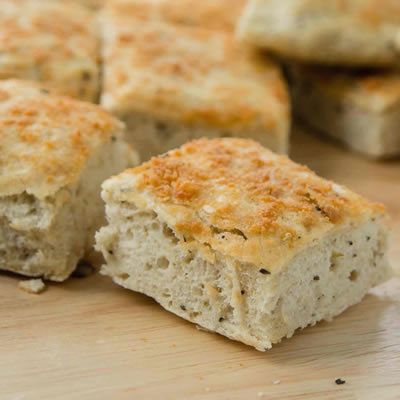
Focaccia
What is Focaccia?
Focaccia is a classic Italian flat bread rich in olive oil and often flavored with fragrant herbs such as crushed rosemary. It can be served whole or sliced in half, then used to make panini, a popular type of Italian sandwich.
Focaccia dough is closely related to that of pizza. However, it does not contain tomato sauce and is much thicker (about 3–4 cm). Focaccia is usually made with olive oil and decorated with things such as:1
- Olives
- Parma ham
- Mozzarella cheese
- Garlic
Origin
As a traditional Italian bread, focaccia is just as popular as ciabatta. Technically, it is a yeast-leavened savory flat bread made in a wood fired oven. However, it can be made in infinite ways. Virtually each region and village in Italy has its own focaccia.
Nowadays, focaccia can be found around the world in artisan bakeries, but most places use a variation of this bread for sandwiches. Focaccia is typically compared to pizza, though focaccia focuses more on the bread and less on the toppings when compared to pizza. In addition, focaccia is generally much thicker than pizza dough.
How Focaccia is made
Focaccia is usually made by using sourdough or yeast preferments. Parmesan cheese is often added to the dough side to impart an extra flavor dimension.
For optimum texture and flavor of this bread, it’s critical to providing sufficient time for fermentation prior to dough mixing. The following formula uses the sponge and dough system:
Sponge (30% flour pre-fermentation):
| Ingredient | Baker’s % (based on flour weight) |
| Patent (bread) flour | 30.0 |
| Water (68°F/20°C) | 20.0 (67.0*) |
| Compressed yeast | 1.5** |
| Total | 51.5 |
*Hydration level, based on the weight of flour used in the sponge
**Yeast amount for a 16-hour sponge fermentation under refrigeration conditions
Dough formulation (67% total hydration):
| Ingredient | Baker’s % (based on flour weight) |
| Patent (bread) flour | 70.0 |
| Water (38°F/3°C) | 47.0 |
| Salt | 2.0 |
| Granulated sugar | 1.0 |
| Olive oil | 10.0 |
| Cheese (grated) | 4.0 |
| Sponge | 51.5 |
| Tomato slices (topping) | Any amount |
| Total | 185.5 |
Processing
- Sponge preparation.
- Ingredients scaling.
- Mixing. Mix at low speed for 2–3 min until well incorporated with a final temperature of 70°F (21°C).
- Sponge fermentation. Allow the sponge to ferment for 1 hour at room temperature 70°F (21°C).
- Dough preparation.
- Scaling of dough ingredients.
- Dough mixing. Incorporate dough side ingredients and sponge at low speed. Then mix to full gluten development and optimum dough consistency. Desired dough temperature out of the mixer is 73–80°F (23–27°C).
- Makeup.
- Sheeting. Sheet bulk dough to target thickness (dusting flour may be needed to ease handling of dough).
- Dividing and shaping. Divide bulk dough into rectangle (scaling weight of dough per full sheet pan depends on pan dimensions and product specifications)
- Panning. Deposit dough on oiled pans, stretch out to edges
- Topping. Add tomato slices on top of dough as desired.
- Final proofing. Proof individual pieces for 1 hour (or full height), at 80°F (26°C) and RH of 65%.
- Baking. Bake focaccia dough at 400°F (200°C) until lightly browned (approximately 20 minutes or to an internal temperature of 204°F (95°C). The higher the oven temperature, the shorter the baking time.
- Cooling. Cool product to loaf internal temperature of 95–105°F (35–40°C) before slicing and packaging
- Slicing.
- Packaging or serving.
Commercial production
Focaccia has traditionally been made in small retail bakeshops. New trends in the bakery industry and increasingly growing sales are opening doors to commercial production of this type of specialty bread.
Application
Specifications for bread flour:2
- Class of wheat: hard red spring (HRS), canadian western red spring (CWRS), hard red winter (HRW), hard white (HW).
- Protein content: higher than 12.0%.
- Ash content: 0.45–0.55%.
- Particle size: 180–220 µm (microns).
- Damaged starch (DS): 6.0–8.0% (based on total flour weight).
- Falling Number (s): 300–350. Sufficient amylase activity to support sponge fermentation without added sugar. Flour with low enzymatic activity (Falling Number > 450 s) should be supplemented with diastatic malt or fungal alpha-amylase.
References
- Haegens, N. “Specialities from All Over the World.” Bakery Products Science and Technology, 2nd edition, John Wiley & Sons, Ltd, 2014, pp. 659–672.
- Finnie, S., and Atwell, W.A. “Composition of Commercial Flour.” Wheat Flour, 2nd edition, AACC International, Inc., 2016, pp. 31–48.

